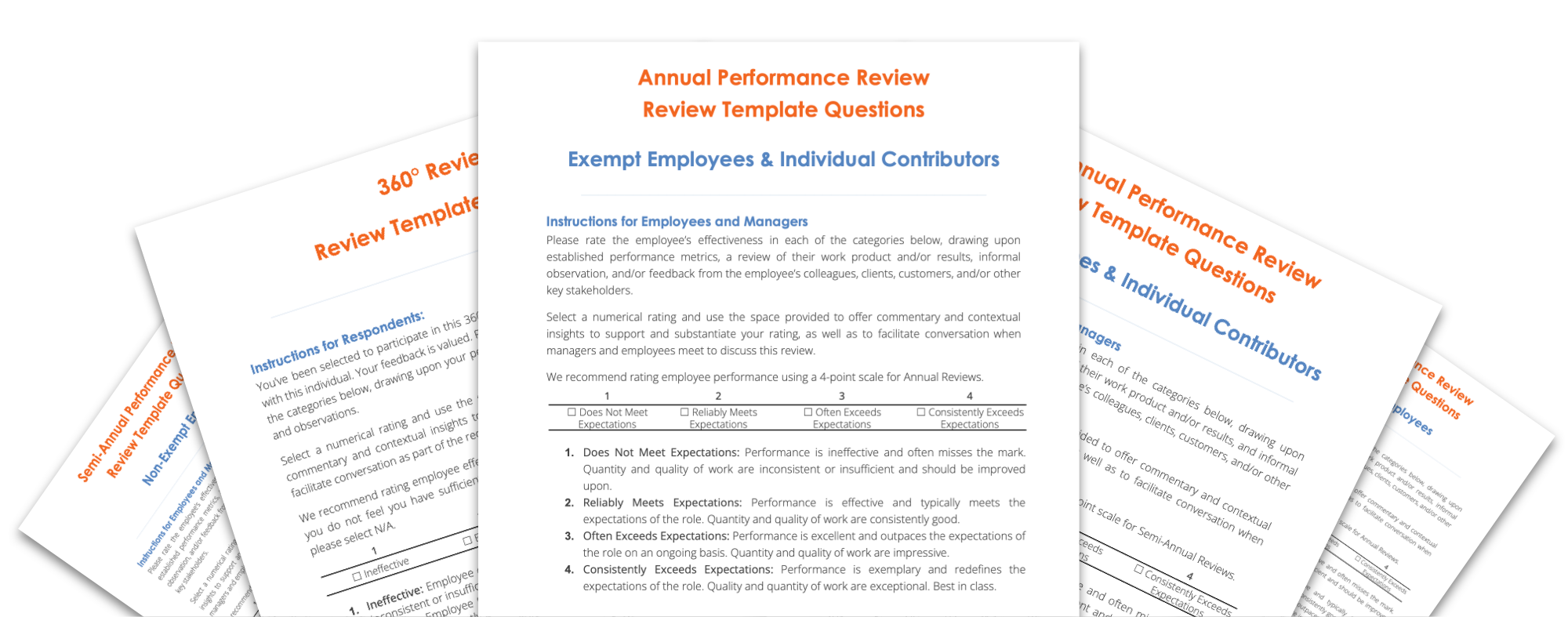Unfortunately, performance review fails are all too common: research shows that managers and employees alike find performance appraisals to be “time-consuming, demotivating, inaccurate, biased, and unfair.” Did you know that only one in five employees are motivated to do great work by current performance management methods? Not to mention, 85% of employees would consider quitting if they felt they received an unfair performance review.
But don’t get discouraged if you think your employees may be feeling the same way. This is an opportunity to strengthen your performance management strategy with more effective employee reviews.
Did you know 85% of employees would quit after an unfair #PerformanceReview? Get 10 key factors for effective #EmployeeReviews:What Makes An Effective Employee Review?
HBR’s Tips for Great Reviews
Harvard Business Review has a few recommendations for organizing effective reviews:
- Clarify the performance review standards.
- Make ample time for review conversations.
- Determine what employees need for great performance — do they lack motivation or training, or would they be more successful in a different role?
- Discover what’s needed to retain and motivate your employees and what they can learn from A Players.
The most effective employee performance reviews:
- Measure performance according to clear expectations
- Occur on a set schedule
- Are fair and unbiased
- Include multiple points of view
- Contain clear, useful feedback
- Focus on how to move forward
- Utilize employee review software
Keep reading for ten key factors to conducting reviews that work.
1. Don’t Surprise Your Employees
Performance evaluations can be stressful — they’ve even made 22% of employees cry. Don’t add to that stress by making them unexpected. Reviews should be conducted regularly, and employees should understand how they work before they take place. Brief them on how to apply rating scales, different types of reviews they’ll receive, and other relevant information so they complete the reviews as intended.
Managers will appreciate the lack of surprises, too. Regular, prescribed reviews means they can be well-prepared and give thorough and accurate performance appraisals.
2. Use Different Review Types
While there’s certainly a need for managers to evaluate their direct reports, that’s only one perspective. Using a variety of formats and participants creates a more complete picture of performance.
There are many types of employee performance reviews:
- Peer Reviews and 360-Degree Feedback add valuable perspectives to employee reviews and give a more accurate view of overall performance.
- New Hire Reviews help ensure new employees are getting the hang of their new jobs and have the resources and training they need to excel. It also tells HR and hiring managers if their onboarding process was effective.
- Quarterly, Semi-Annual, and Annual Performance Reviews present lots of opportunities to talk about performance, set goals, and give constructive feedback in a more formal setting throughout the year.
- Competency- and Roles-Based Reviews enable evaluations that are specific and tailored to skills and positions.
- Time-Based Reviews are triggered at certain intervals during employment — for example, at a busy time of year or six months into a new role.
You can also have employees rate their own performance with self-assessments. That can tell you what they see as their strengths and weaknesses, where they want to grow, and if they have a realistic view of performance.
3. Give Feedback More Than Once a Year
Along the same lines, employee feedback shouldn’t be given just during annual reviews. In fact, 92% of employees want feedback more often than that. Continuous feedback is more effective at helping employees improve performance because it establishes open lines of communication and empowers them to ask questions, get help when they need it, and talk about performance on a daily basis. It also enables managers to recognize great work and motivate their employees consistently.
You can facilitate continuous feedback with tools like weekly one-on-one check-ins and cloud-based HR software where updates can be shared. This means that employees get useful advice on how to adjust their performance and improve throughout the year rather than just during formal reviews.
4. Come Prepared
Managers should start an agenda to guide formal performance review conversations. Just like goal-setting and a regular review cycle help employees prepare for how and when they’ll be evaluated, an agenda prepares them for the review conversation itself. It also helps managers ensure they cover every topic they need to during the evaluation. Make employees active participants in their reviews by asking them to contribute topics to the agenda as well.
Setting an agenda sets the course for a productive #employeeperformance discussion. Find out 9 more tips for effective #EmployeeReviews from @ClearCompany:5. Don’t Rush the Conversation
Set aside ample time for performance reviews — there should be plenty of time to get through agenda items and for employees to ask questions. Dedicating time to performance reviews also demonstrates to employees that they’re worth the time investment. But, you don’t want review conversations to last for hours on end. Reviews that are specific, happen more than once a year, and have a set agenda can be thorough without taking all day.
6. Collaborate to Set Goals
Goal setting has tons of benefits for employee engagement, motivation, and productivity. When employees are able to set and meet goals, it’s a top indicator that they’ll be successful in their role. Performance review goals can help employees understand their role in the big picture, too.
When it comes to performance reviews, goals serve many purposes:
- Provide a means of measuring success
- Set clear expectations about what needs to be accomplished
- Reveal where employees excel and where they need to improve
- Help pinpoint high performers and determine eligibility for promotions
- Add new skills to employees’ skill sets
During evaluations, managers and employees can talk about past goals and work together to set goals for the coming year. However, be sure to let employees take an active role and determine their own goals. According to Lisa Chui, vice president of people at Dascena, “It's best if the employees come up with the goals themselves."
7. Adopt a Coaching Mindset
Managers can do more than give instructions and tell employees what they did and didn’t do well. With a coaching mindset, managers give feedback that serves a purpose. According to leadership coach and consultant Anna Tan,
“Coaching is about helping people embrace different perspectives and embrace new ways of thinking, seeing, and acting in order to achieve a specific result. It does this by making people pay attention to the underlying drivers behind their actions or behaviors rather than just focusing on the end result.”
A coaching mindset is about fostering curiosity and drive that keeps employees engaged and inspired to work toward continuous improvement. It can boost engagement and motivation and take high-performers to the next level.
8. Focus on the Future
One reason traditional employee reviews aren’t helpful? They’re often spent rehashing projects completed months in the past, giving feedback that can’t be applied retroactively. In addition to the continuous feedback we talked about, you can avoid redundant reviews by spending more time talking about how to move forward. This works both for setting higher goals and for addressing those that fell short.
For example, if an employee didn’t reach one of their goals, the conversation should center around how to approach similar goals differently in the future. If the employee crushed another goal, that’s a chance to explore how they can use those skills on a future project.
9. Monitor Performance Trends
You can go from managing performance to optimizing performance when you put data to work. With a performance management system, you can gather employee review data that’s difficult to collect with traditional paper reviews. Robust software systems can produce detailed reports that break down trends across your organization and help you gain a deeper understanding of performance.
You can learn a lot from your performance data:
- See average scores by employee, manager, or department
- View employee performance history
- Spot traits of high-performing employees
- Compare employee scores from peers vs. managers vs. self-assessments
- Identify patterns in performance, e.g. seasonally or during staffing changes
Understanding performance trends can help you address what’s causing them, anticipate upticks or downturns in performance, and maintain fairness.
10. Utilize Performance Management Software
Power these strategies and more with employee review software. A software solution is a valuable tool that can simplify the entire process for your HR team, managers, and employees.
Just a few of the advantages of HR software include:
- Automatic performance review cycles and reminders for on-time evaluations
- Review templates to quickly launch review cycles
- A variety of review types for different roles and purposes
- Customization to tailor employee review questions to your company’s needs
- Access via mobile devices for easier completion
- Goal tracking and alignment for higher engagement and increased transparency
- Real-time feedback opportunities via goal updates
- Built-in employee recognition tools for celebrating big wins and big days
To reap these benefits, monitor employee performance trends, and execute productive reviews, you need a software solution like the ClearCompany Performance Management Platform. Improve performance and engage your employees with reviews that are fair, timely, and comprehensive. As an added bonus, use your company’s employee data to discover trends and refine your performance management strategies.
Begin your most effective review cycle yet with ClearCompany’s Performance Management System. Get a free demo with a ClearCompany expert personalized for your needs — sign up today.



